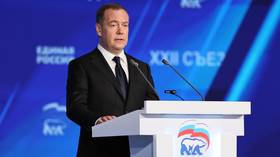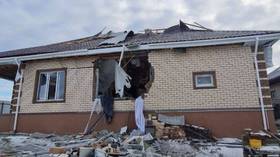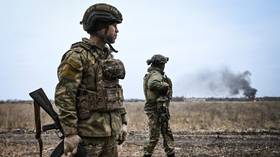Estonia prepares partisans to counter Russian tank attacks

Russia’s envoy to NATO Dmitry Rogozin has admired the “vivid imagination” of the Estonian Defense Minister Mart Laar, who stated that in case of a conflict, his country would be able to bring Russian tank offensives to a halt.
According to the minister, partisans, reservists and directed explosive charges would be enough to slow down the advance of armored vehicles, enabling NATO troops to arrive in the capital of Tallinn prior to the Russians, saving its Baltic member state from the bellicose Russian Bear.“I really appreciate the Estonian Defense Minister’s vivid imagination,” Rogozin told Interfax news agency, commenting on the minister’s statement. The Russian representative to the North-Atlantic alliance said he had known Laar for quite a while – since 1992, when the two met at a gathering of young European political leaders. “He has always been as harmless as a fly and would go into a coma if he saw a toy gun,” Rogozin recalled.The Russian diplomat noted that his opinion about Estonia’s military might is “slightly different” from that expressed by Laar. “Apparently, the minister’s vivid imagination makes up for the lack of skills and combat readiness of the Estonian Army,” he observed.Rogozin recommended that Laar should “take anti-depressants more often”.Earlier, while answering readers’ questions on the Estonian news website Delfi, Laar was certain that his country’s defense forces would manage to counter Russian tank assaults. "If Georgia was able to stop Russian tanks from covering the 90-kilometer stretch between Tskhinval and Tbilisi, what would prevent Estonia from being able to do so?" he said. Whether the Russian troops that took part in the August 2008 conflict to protect South Ossetian and Abkhazian civilians from Georgian attack ever had any intention of overtaking Tbilisi is an entirely different question. But Laar referring to Georgia in such a context is not surprising, since he and President Mikhail Saakashvili are long-time allies. Back in 2006, after the “Rose Revolution”, he was Saakashvili’s advisor as he helped direct the implementation of several radical reforms. In 2010, Saakashvili awarded Laar the St. George's Order – the highest state decoration a foreign national can receive.In his interview with Dlefi readers, Laar claimed that the “potential of our defense forces and our overall planning make this [scenario] possible, as the relevant preparations have already been carried out”. According to the minister, by using mines, blocking roads and blasting bridges, Estonian forces “could significantly slow down” the tanks’ advance.The readers were also keen to know when Estonia would start training partisans for acting “behind enemy lines”. In response, Laar said that such preparations had already begun, adding (like a true partisan) the he could not give any further comments on the matter. Responding to a question in which he was asked whether there would be an easing on restrictions pertaining to the right to bear arms, the minister “highly recommended” his compatriots to join the Kaitseliit, the Estonian Defense League. Laar also said that Estonia was already prepared for the mobilization of its 40,000 reservists in the event of a conflict.Col. Gen. Yury Bukreyev, a former head of the Russian Land Forces' Main Department, believes that the Estonian Defense minister’s rhetoric is nothing but a bluff that could possibly be aimed at drawing Western attention to the Estonian Army."We have never considered such an idea, to say nothing of plans to attack Estonia," Bukreyev told Interfax. “It cannot be ruled out that Estonia is looking for a way to draw the West’s attention to the state of the Estonian Army.The minister did not find a more serious threat than Russian tanks.” He also noted that, as far as he knows, there is not a single Russian tank unit currently in the Western Military District, so “the Estonian minister’s fear is vain”.While picturing the former Soviet Baltic republic as an enemy might seem absurd to the majority of Russians, ghosts from the past apparently still haunt the Estonians. And bigger players from the alliance seem to be adding fuel to the fire, at least according to certain revelations previously made public by WikiLeaks. In December of last year, the whistleblowing website released NATO’s military plans to defend Poland and the Baltic States against a possible Russian attack. According to the leak, which was published by UK’s Guardian newspaper in January 2010, US Secretary of State Hillary Clinton signed a confidential cable, confirming NATO’s commitment to defending Poland and the Baltic States against Russia. In the event of an attack, American, British, German and Polish troops would take up arms along the Baltic front. The military plans were supposed to have been kept secret in order to avoid exacerbating tensions in Russian-NATO relations.














